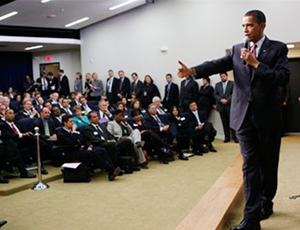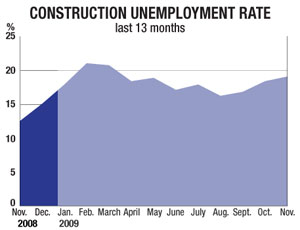Democrats aren’t calling it a new economic-stimulus bill, but momentum is growing in Washington for a new measure aimed at producing more jobs, which would give the economy a lift. Proposals being floated include a new round of federal funding for highways and other infrastructure, probably in the tens of billions of dollars. If the public-works spending becomes a reality, it would provide welcome relief for the construction industry, whose unemployment rate remains the worst among major U.S. business sectors.
The drive for a new jobs bill following the nearly 10-month-old American Recovery and Reinvestment Act received a strong boost on Dec. 8 when President Obama outlined what he would like to see in such a package. His plan would include public-works funding, tax breaks and other help for small businesses and spending on energy-efficiency work.
But Obama’s address didn’t specify how large a package he wants or how much funding he would like to see for various components. It will be up to Congress to provide the specifics. House Democrats have taken the lead, and Speaker Nancy Pelosi (D-Calif.) says she would like to get a bill passed by the end of December. House Majority Leader Steny Hoyer (D-Md.) says lawmakers have discussed total funding of $75 billion to $150 billion for the package.
Obama’s Dec. 8 speech does give added impetus to the push for jobs legislation. He said the economy is improving, but added, “Our work is far from done....Even though we have reduced the deluge of job losses to a relative trickle, we are not yet creating jobs at a pace to help all those families who have been swept up in the flood.”
Obama’s jobs-bill plan includes four main elements:
- Help for small businesses, including eliminating the capital-gains tax on investing in small firms, extending the American Recovery and Reinvestment Act’s accelerated depreciation provision and waiving fees and boosting guarantees for Small Business Administration loans.
- A boost in infrastructure spending. The White House says the spending would go to highways, transit, rail, aviation and water projects. In addition, the White House says it supports “merit-based infrastructure investment that leverages federal dollars.” It cites ARRA’s “TIGER” grant program for major transportation projects as one possible example. Some public-works advocates, including Pennsylvania Gov. Edward Rendell (D), are pushing to have an infrastructure bank included in the jobs legislation.
- Energy efficiency/clean energy. Provisions include rebates for consumers for energy-efficiency retrofits and expanding ARRA programs such as industrial energy-efficiency spending and tax breaks for renewable energy.
- Extend unemployment insurance, payments to senior citizens, COBRA health benefits and direct fiscal relief to states.
To pay for the plan, Obama would tap some unused or repaid Troubled Asset Relief Program (TARP) funds. The TARP program’s cost is expected to be “at least $200 billion less than what was anticipated just this past summer,” he said. Only some of that $200 billion would go for the jobs bill, however. The President said the better-than-expected TARP balance “gives us a chance to pay down the deficit faster than we thought possible.”
Jeffrey Shoaf, the Associated General Contractors’ senior executive director for government affairs, says the speech “finally gets Obama to where the congressional leadership already was” in terms of support for infrastructure funding. “Over the past year or so, the administration’s been the big hurdle in all of this,” he says.
Cathy Connor, Parsons Brinckerhoff’s senior vice president for government affairs, says, “I think it’s extremely...





Post a comment to this article
Report Abusive Comment